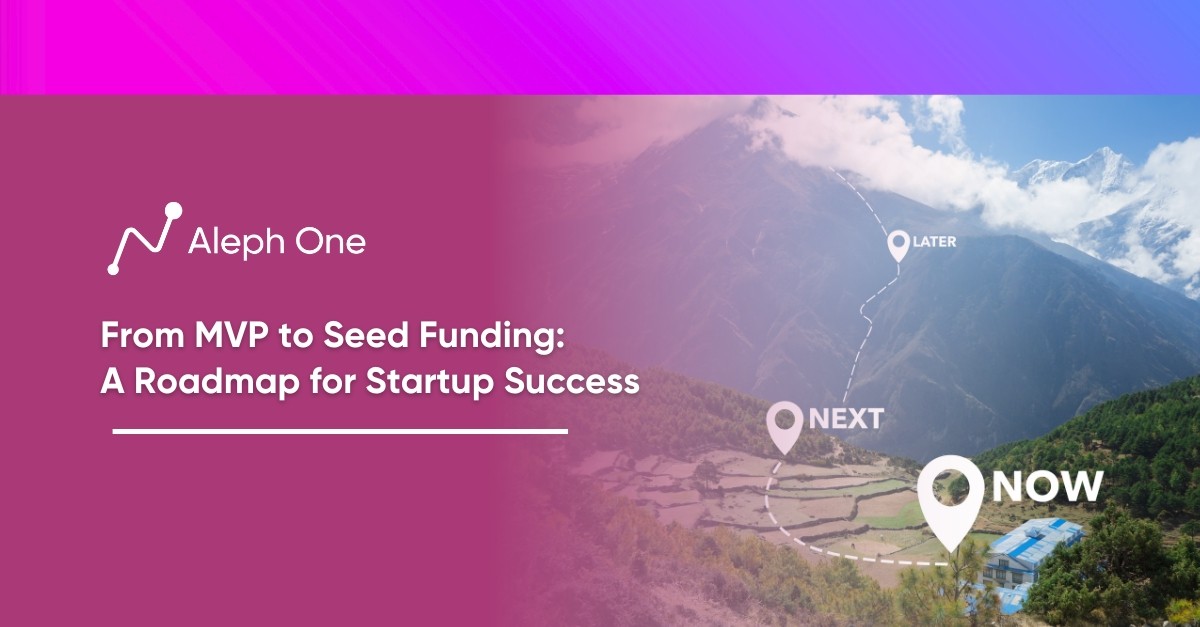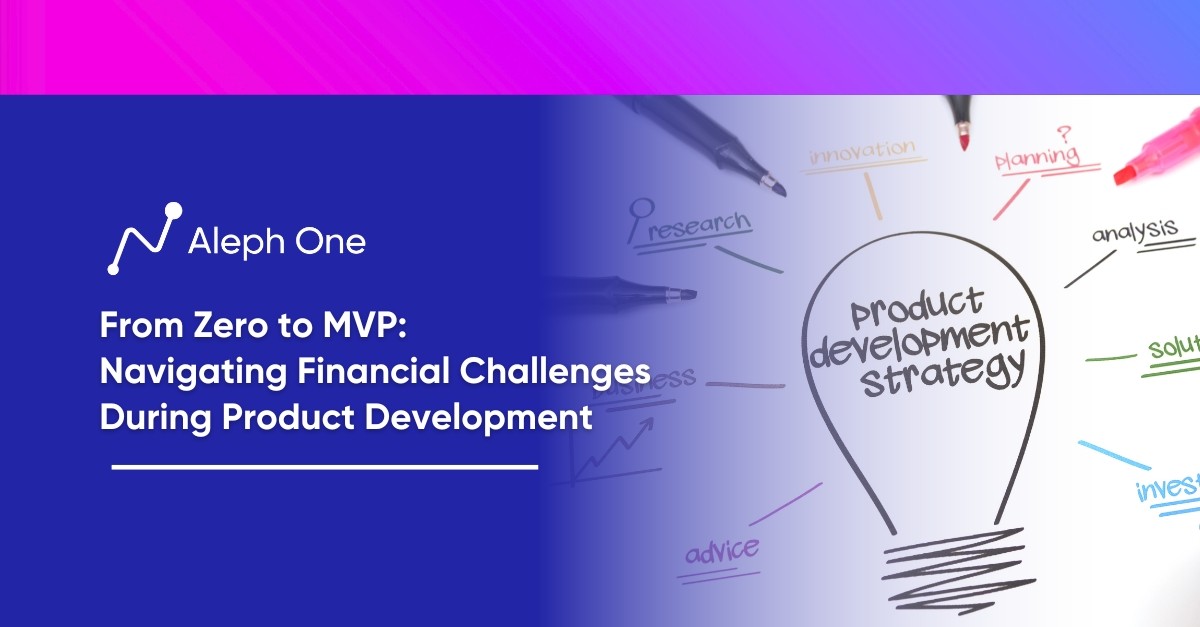Let’s work together to build something amazing. Share your project details and our team will reply to figure out the next steps to your success.

Embarking on building a successful startup is an exhilarating yet challenging endeavor. From MVP to Seed Funding: A Roadmap for Startup Success serves as a guiding light, providing aspiring entrepreneurs with invaluable insights and strategies to navigate the complex landscape of startup growth. By defining a compelling product story that taps into customers’ hopes and dreams, entrepreneurs can inspire others to join their mission. The roadmap emphasizes the importance of testing assumptions through a minimum viable product (MVP), assembling a passionate and talented team, developing a comprehensive roadmap, securing funding, and achieving sustainable growth and scale. With practical tips and real-world examples, this article sets the stage for startup success, unveiling the secrets behind transforming innovative ideas into thriving businesses that have the potential to become unicorns in the startup ecosystem.

Define Your Vision: A Compelling Product Story
Every startup begins with a vision for a product or service that can solve a real customer problem. As an entrepreneur, you need to be able to articulate your vision compellingly. Share how you identified the pain point you want to address and your “aha” moment that led to your business idea.
Research and Validate the Problem
Survey potential customers, analyze existing solutions, and determine why current options are inadequate. Look for problems that are pervasive and persistent, not just minor annoyances. The bigger the problem, the bigger the opportunity.
Develop a Solution
Next, develop a solution that provides a dramatically better experience for customers. Your solution should be innovative, not just an incremental improvement. It must be ten times better than the status quo to inspire customer adoption and gain traction.
Uber, Slack, and Airbnb
For example, consider companies like Uber, Slack, and Airbnb. Uber didn’t just make minor improvements to taxi services. They reimagined the entire experience of hiring a driver with a convenient mobile app, transparent pricing, cashless transactions, and quality ratings. Slack is needed to optimize internal communication. They created a platform that transformed how teams collaborate. Airbnb didn’t just improve vacation rentals. They pioneered a marketplace that gave people an alternative to hotels with more unique, affordable options.
Motivate Your Customers
Your vision should be bold and aspirational. It should tap into customers’ hopes, dreams, and desires to motivate them. When you share your vision, focus on the possibilities for the future and how you will improve people’s lives. Your authentic passion and enthusiasm will inspire others to join you.
With a compelling vision and solution, you have the foundation to build a successful startup. Next, you must test your assumptions and turn your vision into reality. An MVP can help you do just that.
Build an MVP to Test Your Assumptions
Once you have a vision for your product, launch a minimum viable product (MVP) to test your key assumptions. An MVP is a basic first version of your product that allows you to gather feedback from early customers. The goal is not perfection but rather learning and adaptation.
Pre MVP Development
Many successful startups have launched simple MVPs before investing in full product development. Dropbox started as a video explaining cloud storage. Buffer began as a simple landing page to gauge interest in a social media scheduling tool. These MVPs allowed the startups to validate their ideas before building a complex product.
Basic MVPs
Your MVP should be a basic but functional version of your product that addresses your core customer problem. It may have limited features, but it should be enough for customers to understand the concept and benefits. You can then gather feedback to learn how to improve the product. What features do customers want? What needs aren’t being met? What pricing seems fair? An MVP can help determine the answers.
Launching Your MVP
Releasing an MVP allows you to adapt quickly based on real customer data. You can make changes on the fly and push out updates rather than spending months developing an elaborate product in a vacuum. You can also use your MVP to generate revenue and raise initial funding to fuel further growth.
How to Build an Effective MVP
- Focus on your core features that provide value. Leave out the bells and whistles.
- Keep it simple. Refrain from overengineering your solution. An MVP should be basic but useful.
- Define key metrics to measure success. These may include customer feedback, sales, signups, usage, etc.
- Promote your MVP through social media, content marketing, and word-of-mouth to drive traffic and customers.
- Listen to your customers and adapt. Make changes to improve the experience and better meet their needs.
- Leverage tools that allow you to launch fast, like no-code platforms. You can always build more advanced tech later.
An MVP is key to validating your startup vision and gaining momentum. You can build something valuable by starting simple and learning from real customers. Then you’ll be ready to secure funding to scale your product and business.
Assemble Your A-Team: A Guide to Startup Hiring
One of the biggest challenges for early startups is recruiting the right team. As an entrepreneur, you need to find candidates that share your vision and values, have the skills to execute, and have the flexibility to adapt as needed. Start by determining what roles you must fill, such as developers, designers, product managers, and marketing experts. Then establish a hiring process to find the best candidates.
What to Look for In Your Startup Team
Look for people with relevant experience, a startup passion, and a growth mindset for building your startup team. Be flexible in your requirements and consider candidates from diverse backgrounds. For technical roles, evaluate skills and problem-solving abilities through coding tests or design exercises. For other roles, look at work samples and consider transferable skills.
Interview Process and Culture Fit
Once you find promising candidates, conduct thorough interviews to assess culture fit, work ethic, and motivation. Ask open-ended questions to understand their experience, values, and long-term goals. Have candidates meet with multiple team members and evaluate how they engage with others. Ensure candidates understand startup life’s realities like long hours, uncertainty, and limited resources. They must be comfortable with ambiguity and excited to build something from scratch.
Be Transparent
When hiring, be transparent about the challenges of an early startup. Offer competitive pay and equity so people feel invested in the company’s success. Create an environment where people feel empowered to take on responsibility and push the company forward. Foster open communication, collaboration, and feedback culture.
Build a small team of passionate people who share your vision. Keep teams lean in the early days and hire slowly and carefully. It’s better to have a few motivated people than a large uninspired team. With the right hires in place, you’ll have the skills and support system to drive real progress. But also create a culture where people feel ownership over their work and the freedom to be creative. With this combination, you’ll have the perfect foundation for startup success.
Develop a Comprehensive Roadmap
Once you have an MVP and initial team, you need a roadmap to achieve key milestones and gain traction. Set specific, measurable goals to keep your team aligned and accountable. Conduct competitive research to see what other startups in your space are doing and identify opportunities to differentiate.
Define Key Metrics to Track Progress and Success
For an ecommerce startup, this may be monthly active users, conversion rate, and revenue. For an enterprise SaaS startup, focus on customer acquisition costs, churn rate, and lifetime customer value. Review metrics weekly and make changes quickly based on what you learn.
Build Marketing Strategies to Reach Your Target Customers
For a B2C company, focus on content creation, social media, and partnerships. For a B2B startup, prioritize content marketing, search engine optimization, and sales outreach. Start with a few channels and scale up as you gain traction.
Forecast Roadblocks Ahead
Anticipate future challenges and roadblocks, from technical hurdles to fundraising struggles. Have contingency plans in place so you can react quickly. No roadmap survives first contact with customers, so be ready to adapt.
Craft a Roadmap With Milestones
Create a roadmap with concrete milestones for the next 6-12 months. Start with a high-level vision, then break it down into smaller milestones and tasks. Meet with your team regularly to review progress and make changes. Your roadmap should be a living document that evolves as you learn and grow.
With a focused vision, dedicated team, and comprehensive roadmap, you’ll have the foundation to gain real traction and take your startup to the next level. But don’t get too attached to your plans—the reality of building a startup often means pivoting and adapting to change. Stay flexible and open to new opportunities as you work to achieve product-market fit and scale.
Funding Your Vision: From Bootstrapping to VC
As your startup gains traction, you’ll need funding to accelerate growth. The earliest funding often comes from the founders, known as “bootstrapping.” You can bootstrap using your own savings, credit cards, or loans. Many successful startups like MailChimp and GitHub bootstrapped for years before outside funding.
When you’re ready to scale, consider outside funding sources. Crowdfunding platforms like Kickstarter or Indiegogo allow you to raise money from many individuals. You’ll need to offer rewards or equity in exchange for funds. Crowdfunding works best for startups with innovative products that people can get excited about.
Angel Investors
Angel investors are high-net-worth individuals who invest in startups. They often invest at an earlier stage than venture capital firms. Connecting with angel investors at networking events or pitch competitions can lead to investments ranging from $25,000 to $500,000 to get your startup off the ground.
Venture Capital or VC Funding
Venture capital or VC funding involves raising money from institutional investors to accelerate growth. Top VC firms include Sequoia, Andreessen Horowitz, and Kleiner Perkins. Raising a successful VC round can lead to investments of $2 million or more in exchange for equity in your company.
How to Raise VC Funding
To raise VC funding, you’ll need to pitch your vision to partners at various firms. Your pitch should include your product vision, business model, team, milestones achieved, key metrics, and potential for high growth. Be prepared for tough questions about your strategy and financial projections. If interested, a VC firm will issue a term sheet outlining the investment amount and terms.
Evaluate funding offers carefully based on the firm’s experience, networks, and the value they can provide beyond the capital. Consider how much control and equity you’re willing to give up. VC funding can be essential for startups to scale, but too much too early can be risky. You can turn your scrappy startup into a high-growth company with the right funding and partners.
Growth and Scale: How Startups Become Unicorns
The most successful startups can gain momentum and scale into high-growth companies. To become a “unicorn” startup valued at over $1 billion, you need to accelerate growth through customer acquisition, product expansion, and reaching new markets.
Acquire New Customers & Expand
Focus on acquiring new customers through word-of-mouth, referrals, social media, and optimization of your conversion funnels. Look for ways to tap into new customer segments and distribution channels. Expand into new geographic markets and build a global presence.
Expand Your Product Line
Broaden your product line by adding new features, integrations, packages, and adjacent products. Find ways to cross-sell and upsell to your existing customers. Expand into new industry verticals or reach new types of customers. But don’t lose focus of your original vision and value proposition.
Adapt Your Business Model
Consider business model changes to accelerate growth, such as transitioning from a direct sales model to partnerships or a marketplace model. License your technology or platform to new customers. Or franchise your business to scale more rapidly.
Build Partnerships and Alliances
Partnerships and strategic alliances are key ways for startups to gain new customers and distribution channels. Partner with companies that have a similar customer base or complementary products. Pursue co-marketing, reseller, or technology partnerships to reach new markets.
Get Global Reach
International expansion exposes your startup to new growth opportunities and customer segments. Localize your product and marketing for new markets. Initially, focus on English-speaking countries or emerging markets with a growing middle class. Establish a presence through partnerships or subsidiaries and adapt your pricing and business model for local markets.
From Zero to Startup Unicorn
To scale successfully, maintain your vision, values, and culture. Continue to be agile and innovative, not bureaucratic. Invest in your team and infrastructure to support growth. And raise additional funding from VCs and other investors to fuel your expansion. With the right growth strategies and execution, startups can scale into global brands and achieve unicorn status. But always maintain the entrepreneurial spirit that made you successful in the first place.
FAQ
How can entrepreneurs identify the right type of funding for their specific business model and growth stage?
Identifying the right type of funding largely depends on the business model, the stage of the startup, its growth potential, and the market landscape. Startups with strong initial traction and high-growth potential usually attract venture capital. At the same time, businesses with slower and steadier growth may take advantage of options like bootstrapping, bank loans, or private investors. They must also consider each funding option’s trade-offs, such as the amount of equity they are willing to give up and the level of influence external investors may have.
What strategies can startups use to maintain their company culture and values while scaling rapidly?
Maintaining company culture and values during rapid scaling requires proactive efforts. Transparency, frequent communication, and fostering a strong sense of community can help preserve the startup’s core values. It’s also important to ensure that new hires align with the company’s culture and values during recruitment. Leadership must continuously secure this culture by giving clear examples of the company’s values in their decisions and actions and by rewarding those who do the same.
What factors should startups consider when deciding to expand their products or services into new industry verticals or geographic markets?
When considering expanding into new industry verticals or geographic markets, a startup should conduct a thorough market analysis. This includes understanding the potential demand, competition, and any local regulations or customs that may affect their business. They also need to consider whether their existing products or services would appeal to these new markets or need to adapt their offerings or develop new ones to meet specific demands or needs. Evaluating the resources and capabilities is crucial to determine if they can manage expansion growth strategically and responsibly.
Get the latest news and updates from Aleph One in your inbox.



